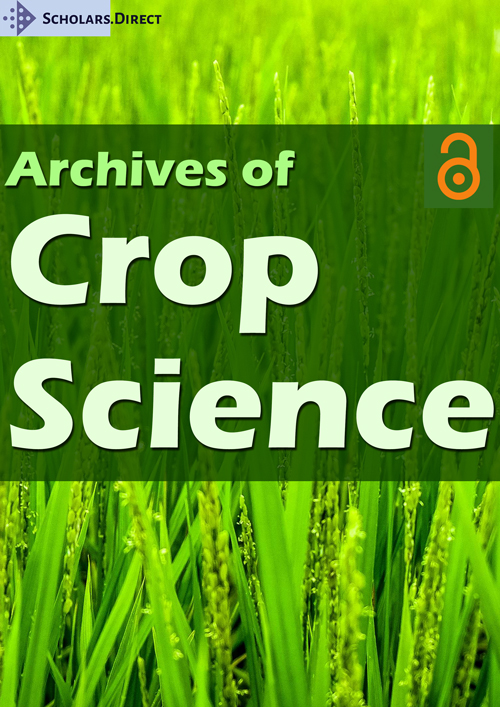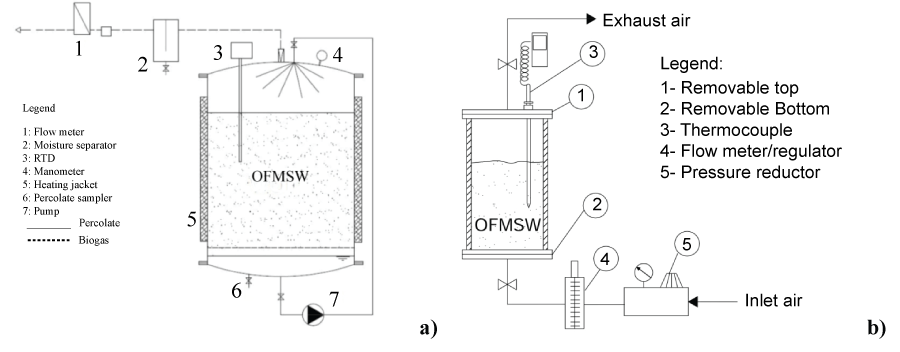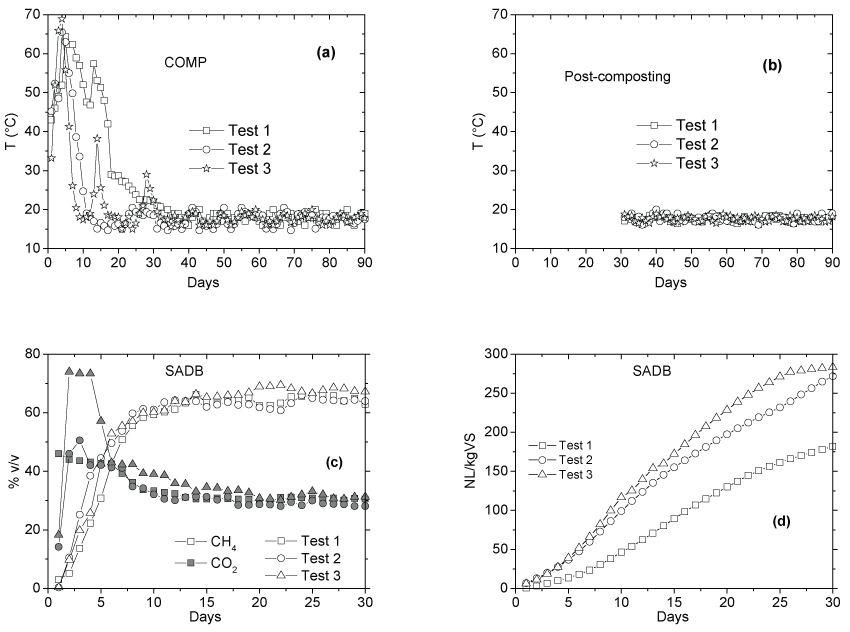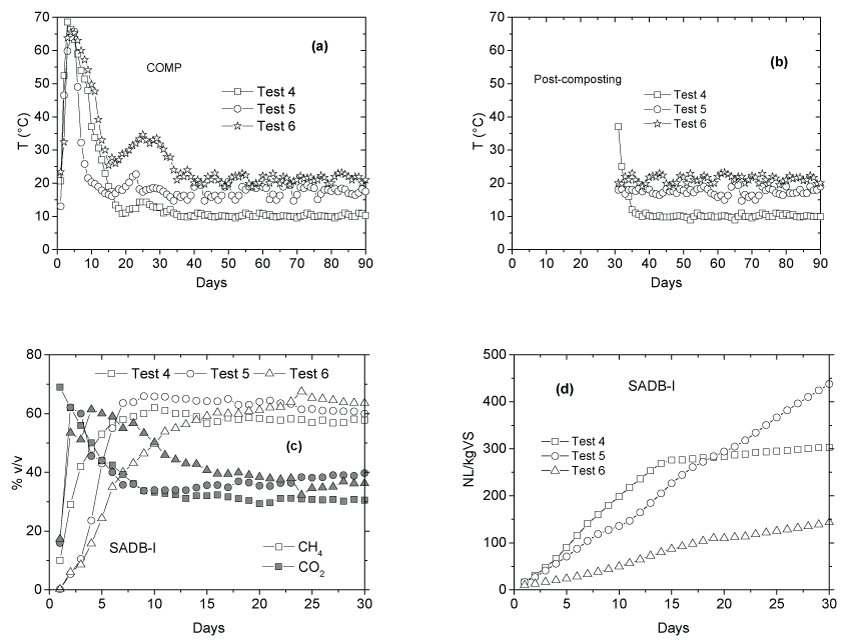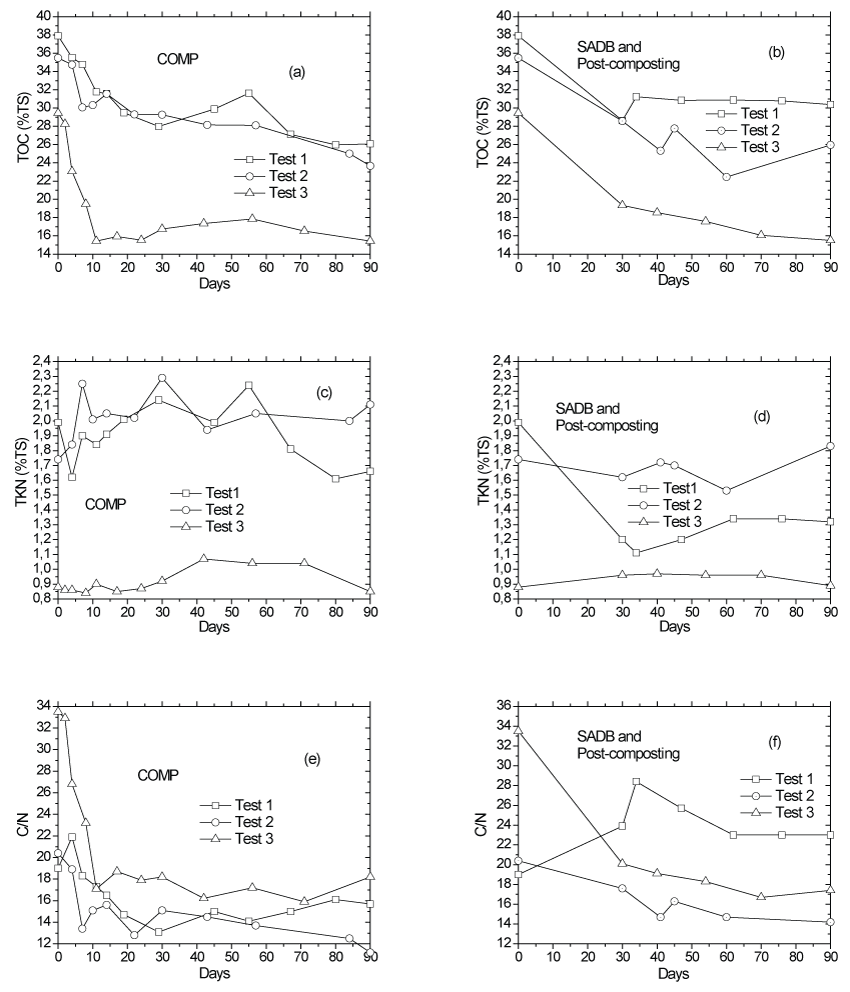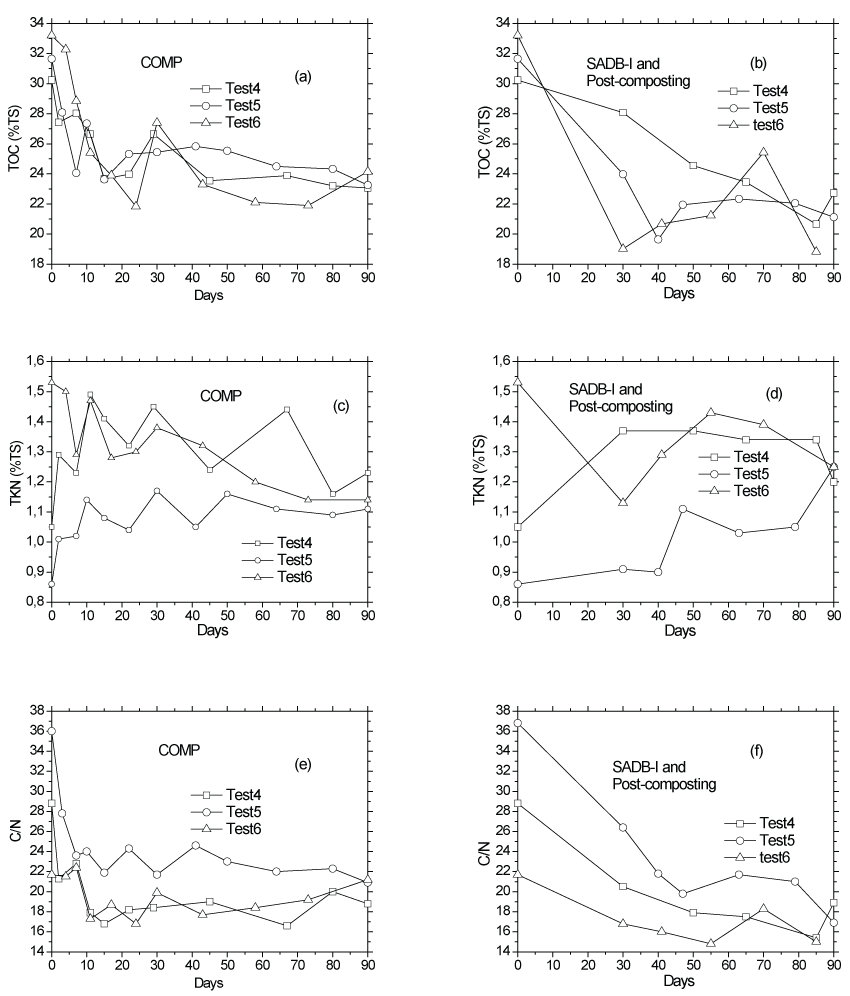Investigation of Biological Processes Aimed at Improving the Quality of Compost from Bio-Waste
Abstract
Exclusively aerobic and integrated anaerobic with post-aerobic treatments of bio-waste generated in a given waste management area were compared with respect to the quality of the final compost. Pilot-scale apparatuses were used for reproducing static aerated pile composting and solid anaerobic digestion batch (SADB) for the anaerobic pre-treatment. Compost was assessed according to the organic carbon content and humic and fulvic acid concentrations. Different runs for the integrated anaerobic and post-composting treatment were also performed to evaluate the effect of SADB inoculation. Inoculated SADB results in a very intensive pre-treatment of the bio-waste leading to the production of a compost with a lower organic carbon content < 24% TS. On the contrary the compost arising from the integrated anaerobic and post-composting process in which SADB was not inoculated gave the maximum organic carbon content, up to 30% TS. Similarly the compost generated by the latter process had a higher degree of humification compared to the exclusively aerobic treatment.
Keywords
Composting, Humification, Humic and fulvic acids, Integrated anaerobic/aerobic treatment, Organic waste, Solid anaerobic digestion batch
Introduction
Bio-waste, the organic fraction (OF) of municipal solid waste and fruit and vegetable waste, is the largest fraction (20% up to 60%) of the municipal solid waste (MSW) generated yearly throughout the world [1,2]. If properly processed it can be an important means for contributing to the restoration of the carbon sink in soils and for substituting mineral fertilizers [3-6]. On the other hand, if not properly managed bio-waste can be a relevant source of gaseous and liquid emissions with a high pollution potential [7-10].
Bio-waste can be successfully recovered by composting, resulting in a soil improver/compost that has been favorably accepted in many areas. In the EU27 about 50% of the entire organic waste generated, corresponding to about 35,000,000 mg, is currently composted [11]. In the USA the amount of waste composted in 2013 was about 25,000,000 mg [12]. Composting, however, requires a rather high energy consumption (i.e., 30-50 kWh) and has direct and indirect emissions [13,14]. Another rather diffused technique for recovering material (e.g.. nutrients and organic carbon) and energy from bio-waste is anaerobic digestion (AD) [15,16]. AD can also play an important role in the waste management sector for contributing to the achievement of EU 2020 goals [17,18] and for improving the energy efficiency of the whole biological treatment of bio-waste. Full-scale AD technologies currently in use are mainly wet and dry ones [19], equipped with continuous flow digesters, able to process substrates with a total solids (TS) concentration < 15% w/w and < 25% w/w, respectively. Before being processed in such facilities, bio-waste requires more or less important pre-treatments, such as mechanical sorting, shredding, metal separation, moisture increase, and pulping, which are costly and complex operations affecting the viability of AD [20]. On the other hand, the main outputs from AD are a biogas rich mainly in methane (i.e., about 60% v/v) and carbon dioxide (i.e., about 40% v/v) and a digestate rich in nutrients and organic carbon with a moisture content (MC) usually > 80% w/w. Digestate with such a high MC is another important technically and economically negative aspect when using AD for waste treatment in many EU areas [21]. In these cases the digestate generally undergoes a preliminary solid/liquid separation process before successive recovery operations. The liquid fraction is generally processed in wastewater treatment plants, whereas the solid fraction is composted. Besides being a further cause of cost increase, the dewatering process can remove up to 80% of the nutrients from the solid fraction of the digestate, consequently reducing their concentration in the final soil amendment [22]. As already demonstrated in previous studies, the Solid Anaerobic Digestion Batch (SADB), which operates with TS up to 40% w/w, can significantly reduce these problems even if biogas yields are lower [9,15,23,24]. The digestate, the liquid fraction generated during SADB, is generally < 10% w/w of the amount of substrate processed [15], whereas the solid fraction is directly treatable through a post-composting phase. A relevant question regarding the batch mode is the use of inoculation. In a previous study [25] reported that the best compromise between energetic and economic performances of SADB was achieved for an inoculum to fresh OFMSW ratio of about 1:1 by weight. As reported by several authors, the post-composting treatment is a mandatory step for reducing the residual phytotoxicity of the digestate and for achieving a high quality and stabilized soil amendment [5,26-28].
Compost quality includes several chemical and physical properties such as pollutant concentration, impurities, residual biological stability, nutrients and organic carbon content [29,30]. The organic carbon content is of particular interest also for CO2 storage [31]. Two processes affect organic matter during biological treatments: mineralization (organic carbon is converted mainly to CO2 and/or CH4) and humification (humus is generated). The humification process, typically occurring under natural soil conditions [32], has started and creates new stabile organic substances (i.e., humic-like substances), with good soil amendment properties. Humus is a composition of humins, humic acids (HA) and fulvic acids (FA). For this reason, biological treatments aimed at material recovery from the bio-waste should generate compost with a high, but also a stable organic matter content. Evaluation of the organic matter together with the HA and FA amounts has been found to be a suitable approach for assessing the quality of compost [29,30,33].
In assessing the amendment properties of the digestate from wet AD of the OFMSW, Tambone, et al. [34] reported a high level of biological stability compared to the fresh material, due to the high degradation of total organic carbon (TOC). Marcato, et al. [35] reported a relevant reduction in digestate biological reactivity compared to the feedstock, and generation of humified substances was limited as well. In another work Tambone, et al. [36] reported a comparative study between digested sludge and compost from OFMSW for assessing, respectively, soil improvement and fertilizing properties. The main findings showed that the digestate had a higher concentration of N (%TS) and K2O (%TS), but a lower concentration of TOC (%TS) compared to the compost. Also in these cases the digestate arose from wet AD.
An exclusive aerobic treatment of OFMSW was investigated by Ruggieri, et al. [37]. They reported an organic matter concentration in the final compost of about 50%TS.
In analyzing the wet anaerobic digestion of food industry waste Ruffino, et al. [38] reported a TS and VS depletion up to 100%, whereas the initial MC of different substrates ranged from about 31% w/w up to about 94% w/w. Novarino and Zanetti [39] reported a TS content in the digestate from wet AD of extruded OFMSW ranging from 3% w/w to 10% w/w, whereas VS reduction ranged from 60% w/w to 70% w/w.
In analyzing the compost obtained from more than 200 facilities, Binner, et al. found a HA content from about 5% TS up to 47% TS. Higher values were achieved through co-composting of non-intensively anaerobically pre-treated bio-waste and stabilized sewage sludge. All these findings demonstrate the relevant role played by both the processes and the feedstock used on the final concentration of HA and FA and hence on the quality of the compost.
Aim of the study
The literature surveyed points out that there is a lack of information on how SADB pre-treatment performs in the production of compost from the OFMSW. Hence, the present study is aimed at investigating this aspect by the aid of a suitably designed experimental pilot-scale apparatus. Integrated SADB with post-composting (PC) and exclusively composting (COMP) processes were compared and the quality of the final amendment was assessed mainly by the content of TOC, HA and FA. The effect of the inoculation of SADB was also investigated.
Material and Methods
Pilot-scale apparatus and runs procedure
Three separate pilot-scale apparatuses were used: one for the SADB test and two for the aerobic processes. The pilot-scale apparatus used in the analysis of the SADB was the same as reported in Di Maria, et al. [16,27]. Briefly it consisted of a 100 liter gas tight anaerobic reactor with a removable top (Figure 1a). The temperature in the bio-waste mass was maintained at 35 ± 2°C by the aid of a thermal heating jacket wrapping the digester and by a 2 cm thick insulated layer. The temperature was continuously monitored with a resistance temperature probe inserted inside the processed substrate. During each test a temporized pump withdrew a given rate of liquid digestate from the reactor bottom and spread it on the bio-waste on the reactor top. Gas produced during the process was continuously withdrawn from the reactor top, piped first to the dehumidification system and then to the thermal gas flow meter (± 0.1 FS). Gas composition was determined with infrared sensors for CH4 and CO2 concentrations (% v/v) (± 1%) and with electrochemical cells for O2 and H2S (% v/v) (± 2%).
Aerobic processes were conducted in a gastight HDPE cylindrical reactor, 30 cm in diameter and 100 cm high (Figure 1b) equipped with a removable top and bottom, reproducing static aerated pile composting. Each cylinder, one for the SADBPC and one for the COMP test, was filled with the solid digestate generated by the SADB and with fresh bio-waste, respectively. 5 Nm3 of air per kgVS of substrate of process air, delivered by a compressor, were injected at the reactor bottom and withdrawn from the reactor top. A pressure reduction system coupled with a flow meter/regulator was used for setting an adequate amount of air, whereas the process temperature was monitored by the aid of a thermocouple inserted directly in the material processed.
The bio-waste exploited for the tests was the OFMSW. Before the activation of each run, about 100 kg of OFMSW arising from the source segregated collection from a given waste management district in central Italy, were withdrawn directly from the collection vehicles.
After preliminary, manual removal of impurities and bulky components, the OFMSW was mixed and two large samples > 20 kg were generated. One sample was processed exclusively by the aerobic apparatus (COMP), whereas the second sample was first processed by the SADB and successively by the aerobic apparatus (SADBPC). Both tests started simultaneously and lasted for 90 days. In the integrated SADBPC, OFMSW was first processed anaerobically for 30 days and then the solid digestate was further treated aerobically for 60 days. Six parallel runs were performed. The first three SADBPC runs were performed without inoculum. In the second three tests, the SADB was inoculated (I) by mixing 1:1 by weight the fresh OFMSW with the digestate generated from the previous SADB run. During the test the following sampling procedure was adopted:
1. One sample of fresh OFMSW at the beginning of each test.
2. For integrated SADBPC one sample at the end of the anaerobic phase and a sample every 15 days during the PC.
3. For COMP a sample every 3 days during the first 15 days, a sample every 7 days for the successive 15 days and the a sample every 15 days until the end of the run.
Due to the length of the entire run time, some differences with the scheduled sampling procedure occurred during weekends or holidays. Each sample, of about 0.5 kg, was first homogenized and blended before chemical characterization.
Chemical characterization
Total solids (TS), moisture content (MC) and volatile solids (VS) were determined according to standard methods [40]. pH was determined on a 1:10 w/v solid/water suspension with a Delta Ohm HD2305.0 instrument. Total organic carbon (TOC) content was determined according to the Springer-Klee wet dichromate oxidation method [41]. Total Kjeldahl-N was determined according to macro-Kjeldahl distillation methods [42]. Humic-like substances from the digestate were extracted and purified according to Ciavatta, et al. [43]. Briefly, this method involved extraction of the humic-like substances with a 0.1 M NaOH and 0.1 M Na4P2O7 solution (1:10 w/v soil to solution ratio) under N2 at 65°C for 24 h. The suspensions were centrifuged at 12000 rpm for 20 min, and the supernatants were filtered through a 0.45 μm membrane filter. An aliquot of the extracts was acidified to pH 2 with concentrated H2SO4 to separate HA from FA. Coagulated HA were collected, while the supernatants containing the FA were further purified on 10 to 12 cm3 of insoluble polyvinylpyrrolidone resin (Aldrich, Germany) previously equilibrated in 0.005 M H2SO4 [44]. The eluate contained the non-humified fraction (NH), characterized by the presence of organic compounds such as carbohydrates, free amino acids, and peptides, which are co-extracted in alkaline solutions [45]. The organic C concentration of the filtered alkaline extract (total extractable C, TEC), as well as that of the NH fraction, was determined using Pt-catalyzed, high-temperature combustion (680°C) followed by infrared detection of CO2 (TOC-5050, Shimadzu Corp., Tokyo, Japan). HA + FA was obtained by taking the difference between TEC and NH. The degree of humification (DH %) was also calculated as the percentage of the ratio (HA + FA)/TEC. All the analyses were carried out in triplicate.
Results and Discussion
Chemical characterization of the OFMSW (Table 1) showed values in line with those reported by other authors. MC ranged from about 50% w/w up to 65% w/w, whereas the VS concentration ranged from about 60% TS up to 77% TS. The organic carbon concentration varied from about 30% TS up to 38% TS, whereas TKN varied from 0.86% TS to 1.99% TS. The HA+FA concentration ranged from about 23% TOC to about 30% TOC with a DH generally lower than 60% with the exception of sample n° 1, which had a DH of about 72%. As expected all the samples had quite acidic pH values with the exception of sample n° 5. For biogenic waste from separate collection, Smidt, et al. [30] reported a TOC ranging from 26% TS to 47% TS, with a corresponding VS concentration ranging from 60% TS to 85% TS. On the other hand a MC of 73% w/w, a VS concentration of 93% TS, a TOC of 29% TS and a TKN of 2.7% TS were reported by Di Maria, et al. [46] for the source-segregated organic fraction of municipal solid waste. Similar results were also reported by Massaccesi, et al. MC and TOC, reported by Sanchez-Mondero, et al., for municipal bio-waste were 59.4% w/w and 35.4% TS, respectively, with a pH of 6.8.
Temperature trends and levels during the COMP indicated that the larger fraction of rapidly degradable organic compounds was oxidized in the first three weeks of the process (Figure 2a and Figure 3a). In the remaining period the temperature was quite constant and similar to the ambient one. Similarly, the quite uniform values for the temperature of the post-composting of the digestate (Figure 2b and Figure 3b) indicate that the SADB pre-treatment was as efficient in the degradation of the organic matter as the COMP process. In particular SADB-I was more efficient than SADB in the mineralization of the organic compounds into biogas, with the exception of test n° 6 (Figure 2c, Figure 2d, Figure 3c and Figure 3d). In fact, on average, SADB-I generated about 300 NL/kgVS versus about 267 NL/kgVS for SADB. The maximum methane content in the biogas (about 60% v/v) was quite similar for both tests, even if SADB-I showed a more rapid increase during the first days. In both cases SADB and SADB-I were operated with a VS concentration of about 270 gVS/kg, with the exception n° 6, which was operated with a VS concentration of about 370 g VS/kg (Table 1). In this case the high content of VS corresponded to a high concentration of rapidly degradable organic compounds. At a concentration > 200 gVS/kg volatile fatty acids are accumulated during alcoholic fermentation and acetogenesis generated relevant inhibition of methanogenesis [46,47]. Inhibition of methanogenesis can be reduced by inoculation of the anaerobic process. An increase in biomethane generation from SADB from about 190 NL/kgVS to about 440 NL/kgVS, operating at about 350 gVS/kg, was reported by Di Maria, et al. [25], exploiting an OFMSW to inoculum ratio ranging from about 1:1 to about 1:5, respectively. Schievano, et al. and Guendoz, et al. [47,48] reported similar results demonstrating that mineralization of organic compounds into CO2 and CH4 was enhanced by the amount of inoculum introduced in the digester.
The higher efficiency of SADB-I in the degradation of the organic compounds was also confirmed by the evolution of the TOC concentration during the tests. After 30 days SADB gave a digestate with a TOC content higher than that of the corresponding COMP process (Figure 4a and Figure 4b), whereas opposite results were obtained for the SADB-I runs (Figure 5a and Figure 5b). The higher value for the TOC concentration detected for the integrated SADBPC was also confirmed at the end of the 90th day (Table 2). In general the nitrogen concentration, expressed as %TS, increased when organic matter losses were greater than the NH3 ones [33]. SADB mineralized a large fraction of organic nitrogen to ammonia that can also be leached by the liquid digestate, modifying its content in the solid digestate. The combination of these two phenomena explains the trends of TKN reported in (Figure 4c, Figure 4d, Figure 5c and Figure 5d).
Due to the higher leachability of ammonium with respect to the organic matter, the C/N ratio can be increased at the end of the SADB pre-treatment (Figure 4f). On the other hand during both COMP and post composting, there was a continuous decrease in the C/N ratio (Figure 4e, Figure 4f, Figure 5e and Figure 5f). The lower TOC degradation together with higher nitrogen volatilization leads to a higher C/N ratio for the compost at the end of SADBPC with respect to the one generated by the corresponding COMP tests (Figure 4e and Figure 4f). Even with the higher C/N ratio the DH% (Table 2) was higher for the compost produced by the former tests. Opposite results were obtained by the test in which SADB was inoculated (Figure 5e, Figure 5f and Table 2).
Ammonium generation is also at the basis of the pH increase determined during both the exclusively aerobic and the integrated tests. The intense microbial activity and TOC degradation during the first weeks of COMP led to the formation of ammonia as a consequence of organic nitrogen ammonification [49]. Then the solubilization of ammonia led to the formation of ammonium and a consequent increase in the pH. There was a similar effect also for the integrated runs. In fact, as is known, anaerobic digestion is very efficient in mineralizing organic nitrogen into ammonia leading, also in this case, to pH increase.
These findings indicate that the quality of the amendment in terms of TOC, HA and FA content was higher for the integrated SADBPC treatment with respect to both SADBPC-I and COMP. The main components of HA and FA are organic carbon and nutrients (e.g., N), which are compounds in a stable form useful for crops and for improving the agricultural properties of soils [29,50]. The final concentration of HA and FA was influenced by several factors among which were their initial concentration in the fresh OFMSW, their compositions, a well-balanced ratio between reactive and less reactive components and the nature and intensity of the processes. As demonstrated by Binner et al. the lack of well-balanced reactive and less reactive organic compounds limits the humification process.
This means that the solid digestate from SADB was characterized by a very favorable balance between the content of less and more reactive organic compounds compared to the digestate from the SADB-I. Consequently the humification process was enhanced compared both to SADBPC-I and COMP (Table 2). The ability of intensive anaerobic digestion to mineralize the organic matter with limited effect on the humic generation process was also reported by Marcato, et al. and Tambone, et al. (2009, 2010). In analyzing more than 200 composting and integrated anaerobic and aerobic treatment facilities for bio-waste, Binner, et al. reported that compost with the higher HA concentration was obtained by anaerobic pre-treatment lasting for a short period (i.e., less intensive). Bernal, et al. reported a HA + FA concentration of about 4.5% TS at the end of the composting process for municipal bio-waste. Sanchez-Mondero, et al. reported a DH of 15% for OFMSW after 19 weeks of composting. For digestate from OFMSW generated after SADB with inoculum, Massaccesi, et al. reported a HA + FA concentration of about 8.5% TS with a corresponding DH of about 67%. A HA + FA concentration up to about 15% TS was reported by Smidt, et al. after anaerobic digestion and successive composting of bio-waste materials.
The concentrations of HA reported in the literature for anaerobic and/or aerobic treatment of different substrates are reported in table 3. There were higher HA concentrations for compost obtained after the aerobic treatment of a 1:1 mixture by weight of bio-waste (i.e., reactive) and yard waste (i.e., less reactive) [29]. Positive effects on the HA generation of well-balanced mixtures was also confirmed for the compost obtained after the post-composting of digestate with fresh bio-waste [30]. In particular SADBPC analyzed in this research showed quite high values of HA and FA compared to those of other studies (Table 3).
Conclusions
Biological processes can play an important role in improving the quality of the final amendment obtainable from bio-waste (i.e., content of organic carbon and of humic compounds). Less intensive treatments such as static instead of turned aerated plies or anaerobic pre-treatments lasting for short periods before post-composting were able to enhance the humification process, increasing the quality of the final compost. Among the different key factors able to enhance the generation of humic compounds during composting, a balanced presence of less and more reactive compounds in the material plays an important role. The solid anaerobic digestion batch (SADB) process showed suitable features as a pre-treatment for achieving this goal. In fact, the partial inhibition due to the high concentration of volatile solids together with the absence of inoculum reduces the intensity of SADB in the degradation of organic compounds. Consequently the digestate was characterized by a balanced concentration of less and more reactive organic materials able to enhance the humification process during the successive post-composting treatment.
The present study showed how a non-intensive anaerobic digestion pre-treatment results in a digested bio-waste with a balanced concentration of less and rapidly biodegradable organic compounds able to increase the quality of the final compost after a post-composting phase. Increase in TOC, HA and FA content together with the possibility of recovering renewable energy makes the SADB and post-composting a suitable treatment for reducing GHG emissions and contributing to the restoration of the carbon sink in soils.
Acknowledgements
The present work was also carried out with the economic support of the LIFE12 ENV/IT/000411 project of the EC.
References
- Burnley SJ (2007) A review of municipal solid waste composition in the United Kingdom. Waste Manag 27: 1274-1285.
- Alexis M Troschinetz, James R Mihelcic (2009) Sustainable recycling of municipal solid waste in developing countries. Waste Manag 29: 915-923.
- Gian Andrea Blengini (2008) Using LCA to evaluate impacts and resource conservation potential of composting: A case study of the Asti District in Italy. Resource Conservation and Recycling 52: 1373-1381.
- Francesco Di Maria, Caterina Micale, Stefano Contini (2016a) Energetic and environmental sustainability of the co-digestion of sludge with bio-waste in a life cycle perspective. Applied Energy 171: 67-76.
- Luisa Massaccesia, Alessio Sordib, Caterina Micaleb, et al. (2013) Chemical characterization of percolate and digestate during the Hybrid Solid Anaerobic Digestion Batch process. Process Biochemistry 48: 1361-1367.
- MA Sanchez-Mondero, A Roig, J Cegarra, et al. (1999) Relationship between water-soluble carbohydrate and phenol fractions and the humification indices of different organic wastes during composting. Bioresource Technology 70: 193-201.
- Gioannis GD, Muntoni A, Cappai G, et al. (2009) Landfill gas generation after mechanical biological treatment of municipal solid waste. Estimation of gas generation rate constants. Waste Manag 29: 1026-1034.
- Umberto Desideri, Francesco Di Maria, Daniela Leonardi, et al. (2003) Sanitary landfill energetic potential analysis: a real case study. Energ Conver Manag 44: 1969-1981.
- Di Maria F, Sordi A, Micale C (2013a) Experimental and life cycle assessment analysis of gas emission from mechanically-biologically pretreated waste in a landfill with energy recovery. Waste Manag 33: 2557-2567.
- Francesco Di Maria, Caterina Micale, Luciano Sisani, et al. (2016b) Treatment of mechanically sorted organic waste by bioreactor landfill: Experimental results and preliminary comparative impact assessment with biostabilization and conventional landfill. Waste Management 55: 49-60.
- ISPRA (2015) Rapporto Rifiuti Urbani. ISPRA, Rapporti 230/2015, Roma.
- Nickolas J Themelis, Ljupka Arsova (2015) Calculating tons to composting in the US. Bio Cycle 56: 27.
- Di Maria F (2012) Upgrading of a Mechanical Biological Treatment (MBT) plant with a Solid Anaerobic Digestion Batch: A Real Case Study. Waste Manag Res 30:1089-1094.
- Weidema BP, Bauer C, Hischier R, et al. (2013) Overview and methodology. Data quality guideline for the ecoinvent database version 3. Ecoinvent Report 1(v3), St. Gallen, The ecoinvent Centre.
- Bolzonella D, Pavan P, Mace S, et al. (2006) Dry anaerobic digestion of differently sorted organic municipal solid waste: a full-scale experience. Water Sci Technol 53: 23-32.
- F Di Maria, A Sordi, C Micale (2012a) Energy production from mechanical biological treatment and composting plants exploiting solid anaerobic digestion batch: an Italian case study. Energy Conversion and Management 56: 112-120.
- (2001) Directive 2001/77/CE of the European Parliament and of the Council of 27 September 2001 on the promotion of the electricity produced from renewable energy sources in the internal electricity market. Official Journal of the European Communities .
- Beurskens LWM, Hekkenberg, M, Vethman P. ECN - renewable energy projection as published in the national renewable energy action plans of the European Members States.
- De Baere L, Mattheuws B (2010) Anaerobic digestion in Europe: state of the art 2010. In: Proceedings of 7th International ORBIT Conference, Heraklion, Crete.
- M Vinot, CA Perez, P Turm, et al. (2010) Improvements in anaerobic digestion units and in pre-treatments performances beforehand. In: Proceedings of the Third International Symposium on Energy from Biomass and Waste Venice, Italy.
- Fricke K, Santen H, Wallmann R (2005) Comparison of selected aerobic and anaerobic procedures for MSW treatment. Waste Manag 25: 799-810.
- Rico C, Rico JL, Tejero I, et al. (2011) Anaerobic digestion of the liquid fraction of dairy manure in pilot plant for biogas production: residual methane yield of digestate. Waste Manag 31: 2167-2173.
- ten Brummeler E (2000) Full scale experience with the BIOCEL process. Water Sci Technol 41: 299-304.
- Yebo Li, Stephen Y Park, Jiying Zhu (2011) Solid-state anaerobic digestion for methane production from organic waste. Renewable and Sustainable Energy Reviews 15: 821-826.
- Francesco Di Maria, Alessio Sordi, Caterina Micale (2012b) Optimization of Solid State Anaerobic Digestion by inoculum recirculation: The case of an existing Mechanical Biological Treatment plant. Applied Energy 97: 462-469.
- Abdullahi YA, Akunna JC, White NA, et al. (2008) Investigating the effects of anaerobic and aerobic post-treatment on quality and stability of organic fraction of municipal solid waste as soil amendment. Bioresource Technology 99: 8631-8636.
- Di Maria F, Sordi A, Cirulli G, et al. (2014) Co-treatment of fruit and vegetable waste in sludge digesters. An analysis of the relationship among bio-methane generation, process stability and digestate phytotoxicity. Waste Manag 34: 1603-1608.
- Ponsa S, Gea T, Alerm L, et al. (2008) Comparison of aerobic and anaerobic stability indices through a MSW biological treatment process. Waste Manag 28: 2735-2742.
- Binner E, Smidt E, Tintner J, et al. (2011) How to enhance humification during composting of separately collected biowaste: impact of feedstock and processing. Waste Manag Res 29: 1153-1163.
- Ena Smidt, Johannes Tintner, Katharina Bohm, et al. (2011) Transformation of Biogenic Waste Materials through Anaerobic Digestion and Subsequent Composting of Residues - A Case Study. Dynamic Soil, Dynamic Plant 5: 63-69.
- Linzner R, Mostbauer P (2005) Composting and its impact on climate change with regard to process engineering and compost application - a case study in Vienna. In: proceedings of Sardinia 2005. Tenth International landfill Symposium, CISA publisher, Cagliari.
- Nicola Senesia, Cesar Plazab, Gennaro Brunetti (2007) A comparative survey of recent results on humic-like fractions in organic amendments and effects on native soil humic substances. Soli Biology & Biochemistry 39: 1244-1262.
- MP Bernai, C Paredes, MA Sanchez-Monedero, et al. (1997) Maturity and stability parameters of composts prepared with a wide range of organic wastes. Bioresource Technology 63: 91-99.
- Tambone F, Genevini P, D'Imporzano G, et al. (2009) Assessing amendment properties of digestate by studying the organic matter composition and the degree of biological stability during the anaerobic digestion of the organic fraction of MSW. Bioresour Technol 100: 3140-3142.
- Claire-Emmanuelle Marcatoa, Rabi Mohtarb, Jean-Claude Revel, et al. (2009) Impact of anaerobic digestion on organic matter quality in pig slurry. International Biodeterioration & Biodegradation 63: 260-266.
- Fulvia Tambone, Barbara Scaglia, Giuliana D'Imporzano, et al. (2010) Assessing amendment and fertilizer properties of digestates from anaerobic digestion through a comparative study with digested sludge and compost. Chemosphere 81: 577-583.
- Luz Ruggieria, Teresa Geaa, Marisol Mompeo, et al. (2008) Performances of different systems for the composting of the source-selected organic fraction of municipal solid waste. Biosystems Engineering 101: 78-86.
- Ruffino B, Fiore S, Roati C, et al. (2015) Scale effect of anaerobic digestion tests in fed-batch and semi-continuous mode of the technical and economic feasibility of full scale digester. Bioresour Technol 182: 302-313.
- Novarino D, Zanetti MC (2012) Anaerobic digestion of extruded OFMSW. Bioresour Technol 104: 44-50.
- (1992) APHA. Standard methods for the examination of water and wastewater, (18th edn) American Public Health Association, Washington, DC, USA.
- Nelson DW, Sommers LE (1996) Total carbon, organic carbon and organic matter. In: Bigham JM, Methods of soil analysis. Part. 3- chemical method 61-1010.
- (2001) ANPA (Agenzia nazionale per la protezione dell'Ambiente). Metodi di analisi del compost. Manuali e linee guida 3.
- Ciavatta C, Govi M, Antisari L V, et al. (1990) Characterization of humified compounds by extraction and fractionation on solid polyvinylpyrrolidone. Journal of Chromatography 509: 141-146.
- F Petrussi, M De Nobili, M Viotto, et al. (1988) Characterization of organic matter from animal manures after digestion by earthworms. Plant and Soil 105: 41-46.
- (1979) Cheshire, M.V. Nature and origin of carbohydrates in soil. Academic Press, London.
- Di Maria F, Gigliotti G, Sordi A, et al. (2013b) Hybrid solid anaerobic digestion batch: Biomethane production and mass recovery from the organic fraction of solid waste. Waste Manag Res 31: 869-873.
- Schievano A, D'Imporzano G, Malagutti L, et al. (2010) Evaluating inhibition conditions in high-solids anaerobic digestion of organic fraction of municipal solid waste. Bioresour Technol 101: 5728-5732.
- Guendouz J, Buffiere P, Cacho J, et al. (2010) Dry anaerobic digestion in batch mode: design and operation of a laboratory-scale, completely mixed reactor. Waste Manag 30: 1768-1771.
- Sanchez-Monedero MA, Roig A, Paredes C, et al. (2001) Nitrogen transformation during organic waste composting by the Rutger system and its effects on pH, EC and maturity of the composting mixtures. Bioresour Technol 78: 301-308.
- Kurt Moller, Torsten Muller (2012) Effects of anaerobic digestion on digestate nutrient availability and crop growth: A review. Engineering in Life Science 3: 242-257.
Corresponding Author
Francesco Di Maria, LAR Laboratory, Dipartimento di Ingegneria, Via Goffredo Duranti, Perugia, Italy, Tel: +39-0755853738.
Copyright
© 2016 Di Maria F. This is an open-access article distributed under the terms of the Creative Commons Attribution License, which permits unrestricted use, distribution, and reproduction in any medium, provided the original author and source are credited.

